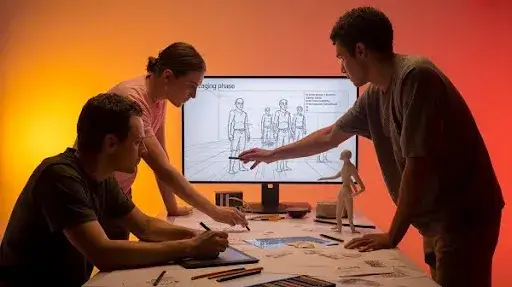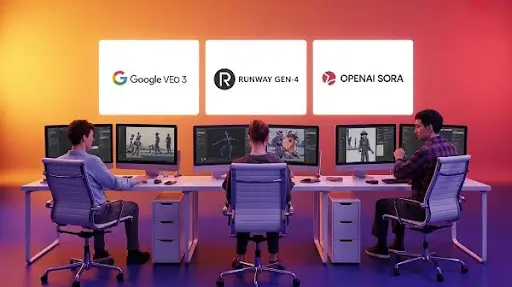Great animation isn’t about how many frames you draw or how glossy the render looks. It’s about clarity. The audience should know exactly where to look, what to feel, and why the moment matters—without being spoon-fed. That invisible hand guiding their eyes and emotions? That’s staging in animation.
When staging is sharp, a scene lands immediately. The emotion clicks, the meaning is clear, and the story keeps moving. When it’s sloppy, viewers get lost, no matter how beautiful the visuals might be. That’s why this principle is often called the spine of animation—it quietly holds everything together.
What Is Staging in Animation?
Think of staging as clarity in motion. Every pose, every pause, every camera choice serves one purpose: making the idea unmistakable the first time you see it.
The pioneers of animation, Walt Disney and his team, put staging right at the top of their playbook. It was number three in their famous Twelve Principles of Animation. They weren’t chasing flash. They were chasing discipline—making sure every thought, gag, or emotion was instantly obvious.
So, what does staging really cover? Placement of characters. The rhythm of their movements. The angle of the camera. Even the background design. Every decision layers together, pointing the viewer’s focus to the right spot at the right moment.
Why Staging Is Important for Animation
No frame exists without a reason. It might be setting up a joke, building suspense, or hinting at a hidden emotion. Without staging, those intentions fall flat.
Done right, staging ensures:
- The eye goes to the action that matters.
- Emotions read the moment they appear.
- The story flows without distractions.
- Viewers stay connected without confusion.
For studios delivering high quality 3D animation services, this principle is what separates content that only looks good from content that actually feels right.
The Staging Rule Explained
Here’s the staging rule in plain terms: the audience should understand an action the very first time it’s shown.
That doesn’t mean every move needs to be exaggerated or loud. It means being deliberate about what happens, when it happens, and how it’s framed. Two actions fighting for attention cancel each other out. A sad character won’t read as sad if the lighting, timing, or camera angle is pulling in a different direction.
Strong staging is less about adding layers of detail and more about stripping away the noise. Clarity beats complexity.
Key Elements of the Staging Principle
Breaking staging into its key parts shows how it actually works in practice. These building blocks decide if a scene is crystal clear or muddled.
Acting: Strong Poses and Clear Movement
Acting in animation isn’t just eyebrows and lip sync. The whole body tells the story. Silhouette, weight, and rhythm carry meaning just as much as dialogue.
Disney’s animators mastered this early on. With only pencil drawings, they relied on poses that read instantly—even as simple silhouettes. If the outline alone told you the action, the staging was working.
Modern films keep that tradition alive. In Spider-Man: Into the Spider-Verse, every swing across the skyline has a bold pose that sells the movement before the details even kick in. If a pose looks muddy, the staging needs fixing.
Timing and Spacing in Animation
Timing sets the beat. Spacing controls the feel of that beat. Together, they make the motion readable.
Clean timing keeps a scene from turning into a blur. Spacing adds flavor—slow and heavy for drama, quick and sharp for energy.
Comedy often hinges on this. Hold a pause just long enough before a gag, and it lands. Emotional moments need it too, giving the audience space to breathe. Without careful timing and spacing in animation, staging loses its punch.
Camera: Angles That Shape Meaning
The camera doesn’t just record—it tells the story.
- Close-ups amplify emotion.
- Wide shots set the stage.
- Low angles give characters power.
- High angles make them vulnerable.
Good staging uses these tools like a director would. A frame that’s composed with care points the eye exactly where it should go. A frame that’s careless weakens everything, no matter how well animated.
Settings and Environment
Backgrounds aren’t filler. They guide the story too. Props, scenery, and layout influence how the action is read.
Clutter steals focus. Flat design makes scenes feel empty. The sweet spot lies in balance—an environment that supports the characters without overshadowing them.
That balance is what makes staging in story design truly work.
Staging Beyond Animation
While staging is written into the principles of animation, it’s not limited to cartoons or 3D work. Filmmakers lean on the same ideas every day. Camera placement, pauses, and blocking guide an audience in live action just as effectively as they do in animation.
That’s what makes staging so powerful. It’s less about medium and more about communication. The clearer the staging, the easier it is for audiences to follow even the most complex moments.
At Prolific Studio, staging drives every project—short promos, branded 3D spots, or long-form storytelling. For clients seeking high quality 3D animation services, staging guarantees that polish comes with purpose. It’s not just about pretty visuals—it’s about clarity, meaning, and connection.
Applying Staging in Different Types of Animation
At first, staging seems like an easy rule to follow. In reality, it bends and shifts depending on the project. A quick 2D short, a full-length 3D feature, or a fast-paced ad all have different needs. The aim—clarity—stays the same, but the path looks different.
Staging in 2D Animation
In hand-drawn animation, clarity comes from strong poses and bold silhouettes. No fancy depth tricks here. Line of action, timing, and spacing carry the weight. Think of Bugs Bunny—he barely needs words. A tilt of the head, a still pause, then the gag lands.
Ghibli’s work shows the quieter side of it. A character pausing by a window, or the way a simple head turn holds just long enough—small moves, but they read clearly. That’s the strength of 2D: staging can make even silence feel alive.
Staging in 3D Animation
3D animation gives animators extra tools—camera angles, depth of field, lighting. Sounds like an advantage, right? It is, but it can also be a trap. A detailed world looks amazing yet pulls the viewer away from the actual story.
That’s why studios offering 3D animation services lean heavily on blocking and animatics first. They strip a shot down to basics, making sure the action reads before pouring on detail. Once that works, polish can follow.
The trick is focus. Keep the character sharp. Let the background breathe. Guide the eye, don’t overload it.
Staging in Motion Graphics and Commercials
Commercials play by different rules. There’s no luxury of time—you’ve got seconds to catch attention. That means staging has to be instant.
Crowded screens don’t work. If text, icons, and motion fight each other, the message dies before it starts. The fix is simplicity: bold motion, strong contrast, and as little clutter as possible.
Common Staging Mistakes (and Fixes)
Even pros miss the mark. The usual slip-ups look like this:
- Overstuffed shots – too much happening at once. Cut it down.
- Poses that don’t read – silhouettes should make sense in black and white.
- Timing that’s off – too rushed or too slow. Match it to the mood.
- Camera tricks everywhere – spinning shots aren’t always better.
- Backgrounds stealing the show – the set should frame the action, not fight it.
A good habit? Pause the video anywhere. If someone new can’t instantly tell what’s going on, the staging isn’t strong enough.
Strengthening Your Staging
Better staging doesn’t come from expensive tools—it’s about habits:
- Scribble quick thumbnails before animating.
- Use contrast to highlight the main action.
- Frame with the rule of thirds.
- Let key poses hold long enough to land.
- Cut anything that doesn’t earn its spot.
These apply to everything, from beginner flipbooks to complex 3D animation layouts.
Why Staging and Storytelling Go Together
At its core, staging isn’t decoration—it’s how story gets across.
In comedy, it’s the tiny pause before the punchline that makes the laugh land. In drama, it’s the silence between words or the way a character lowers their head. Mess up staging, and both moments fall flat.
It’s the link between what the animator imagines and what the audience feels.
Frequently Asked Questions
Is staging just about the camera?
No. The camera matters, but so do poses, timing, spacing, and backgrounds.
How is animation staging different from live-action?
The core idea is the same: clarity. The difference is that in animation, nothing happens by chance—every element is built, so responsibility is heavier.
Can staging be taught?
Yes. Some people spot clarity naturally, but practice and feedback sharpen it fast.
What tools help in 3D?
Storyboards, blocking, animatics, and silhouette tests. Many studios offering 3D animation services rely on them before rendering.
Why does poor staging ruin even stunning visuals?
Because clarity beats beauty. If the audience doesn’t know where to look, the scene fails.
Wrapping It Up
Staging is more than a checklist item—it’s the backbone of animation. It tells the eye where to go, sets the tone, and keeps the story flowing. Whether you’re watching a classic 2D short or a modern 3D blockbuster, staging is the invisible hand that makes it work.
For animators, it’s the art of clear communication. For animation studios in Washington DC delivering high-quality 3D animation services, it’s what turns good renders into memorable experiences.
At the end of the day, animation isn’t just movement—it’s meaning.










